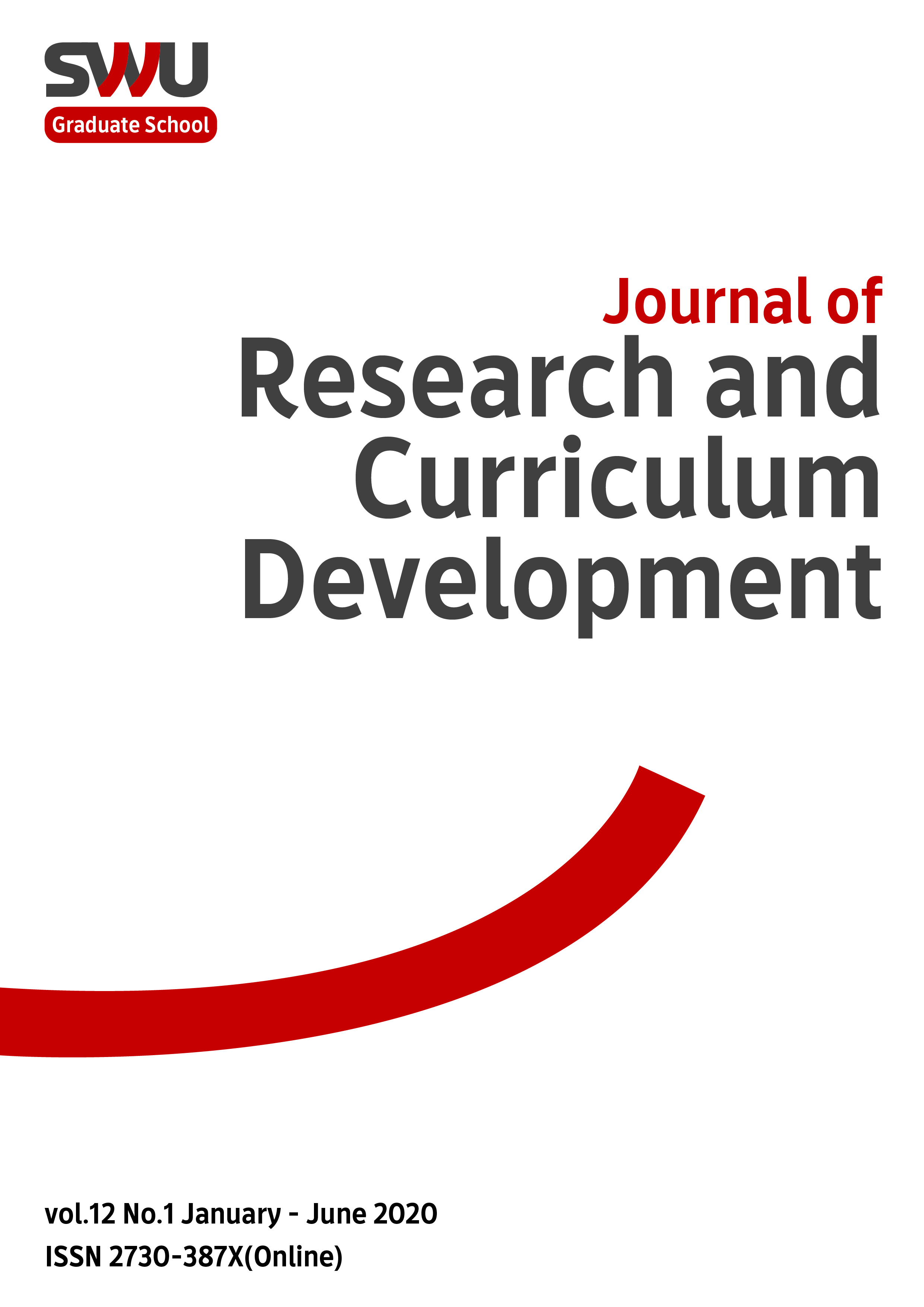Validating a Design-Thinking Mindset Questionnaire with Thai Secondary School Students
Keywords:
Design thinking, Factor analysis, Measurement, STEM educationAbstract
Science, Technology, Engineering, and Mathematics (STEM) education, as an educational policy, provides opportunities for students to learn science and mathematics in more integrated ways than the use of traditional methods. This can be pedagogically accomplished via a design-based approach, in which students engage in collaboratively solving engineering problems using various domains of knowledge and skills. In this pedagogical process, design thinking is vital. However, given that design thinking is a complex construct, a way in which it can be practically measured in an effective way has yet to be sufficiently developed. This may become a limitation, because teachers need to assess whether or not students are in the process of developing design thinking while engaged in design-based activities. In an attempt to support teachers in measuring the design thinking of students in a practical way, the current study aims to develop and validate a five-point Likert-scale questionnaire, based on 892 Thai secondary students subsequently using exploratory and confirmatory factor analyses. The results revealed that the six components of design thinking can be measured by 28 items on the questionnaire. It may be recommended that, in addition to other methods, such as a think-aloud protocol, the questionnaire can be used to measure the design thinking of the students.
References
Aflatoony, L., Wakkary, R., & Neustaedter, C. (2018). Becoming a design thinker: Assessing the learning process of students in a secondary level design thinking course. International Journal of Art and Design Education, 37(3), 438-453. https://doi.org/10.1111/jade.12139.
Blizzard, J., Klotz, L., Potvin, G., Hazari, Z., Cribbs, J., & Godwin, A. (2015). Using survey questions to identify and learn more about those who exhibit design thinking traits. Design Studies, 38, 92-110. https://doi.org/10.1016/j.destud.2015.02.002.
Brenner, W., Uebernickel, F., & Abrell, T. (2016). Design thinking as mindset, process, and toolbox: Experiences from research and teaching at the University of St.Gallen. In B. Walter & U. Faik (Eds.). Design Thinking for Innovation: Research and Practice. (pp. 3-21). Cham: Springer International Publishing Switzerland. https://doi.org/10.1007/978-3-319-26100-3_1.
Cook, K. L. & Bush, S. B. (2018). Design thinking in integrated STEAM learning: Surveying the landscape and exploring exemplars in elementary grades. School Science and Mathematics, 118(3-4), 93-103. https://doi.org/10.1111/ssm.12268.
Dosi, C., Rosati, F., & Vignoli, M. (2018). Measuring design mindset. Proceedings of the 15th International Design Conference - Design 2018. https://doi.org/10.21278/idc.2018.0493.
Dym, C. L., Agogino, A. M., Eris, O., Frey, D. D., & Leifer, L. J. (2005). Engineering design thinking, teaching, and learning. Journal of Engineering Education, 94(1), 103-120. https://doi.org/10.1002/j.2168-9830.2005.tb00832.x.
Gracio, A. H. L., & Rijo, C. (2017). Design thinking in the scope of strategic and collaborative design. Strategic Design Research Journal, 10(1), 30-35. DOI: 10.4013/sdrj.2017.101.04.
Hess, J. L., & Fila, N. D. (2016). The manifestation of empathy with design: Finding from a service-learning course. CoDesign, 12(1-2), 93-111. https://doi.org/10.1080/15710882.2015.1135243.
Howard, M. C. (2016). A review of exploratory factor analysis decisions and overview of current practices: What we are doing and how can we improve? International Journal of Human-Computer Interaction, 32(1), 51-62. https://doi.org/10.1080/10447318.2015.1087664.
Institute of Design at Stanford. (2019). An introduction to design thinking process guide. Retrieved from https://dschool-old.stanford.edu/sandbox/groups/designresources/wiki/36873/attach
ments/74b3d/ModeGuideBOOTCAMP2010L.pdf.
Kelly, T. R. & Knowles, J. G. (2016). A conceptual framework of integrated STEM education. International Journal of STEM Education, 3, Article No. 11. https://doi.org/10.1186/s40594-016-0046-z.
Li, Y., Schoenfeld, A. H., diSessa, A. A., Graesser, A. C., Benson, L. C., English, L. D., & Duschl, R. A. (2019). Design and design thinking in STEM education. Journal of STEM Education Research, 2(2), 93-104. https://doi.org/10.1007/s41979-019-00020-z.
Marks, J. & Chase, C. C. (2019). Impact of a prototyping intervention on middle school students’ iterative practices and reactions to failure. Journal of Engineering Education, 108(4), 547-573. https://doi.org/10.1002/jee.20294.
Mentzer, N., Becker, K., & Sutton, M. (2015). Engineering design thinking: High school students’ performance and knowledge. Journal of Engineering Education, 104(4), 417-432. https://doi.org/10.1002/jee.20105.
Paparo, M., Dosi, C., & Vignoli, M. (2017). Towards a DT Mindset Tool Evaluation: Factors identification from theory and practice. Proceedings of the 21st International Conference on Engineering Design. (pp. 367-376). 21-25 August 2017, Vancouver, Canada.
Promboon, S., Finley, F. N., & Kaweekijmanee, K. (2018). The evolution and current status of STEM education in Thailand: Policy directions and recommendations. In G. W. Fry (Ed.). Education in Thailand: An Old Elephant in Search of a New Mahout (pp. 423-459). Singapore: Springer. https://doi.org/10.1007/978-981-10-7857-6_17.
Quinn, C. M., Reid, J. W., & Gardner, G. E. (2020). S + T + M = E as a convergent model for the nature of STEM. Science and Education, 29(4), 881-898. https://doi.org/10.1007/s11191-020-00130-w.
Razzouk, R. & Shute, V. (2012). What is design thinking and why is it important? Review of Educational Research, 82(3), 330-348. https://doi.org/10.3102/0034654312457429.
Schweitzer, J., Groeger, L., & Sobel, L. (2016). The design thinking mindset: An assessment of what we know and what we see in practice. Journal of Design, Business and Society, 2(2), 71-94. https://doi.org/10.1386/dbs.2.1.71.
Sheffield, R., Blackley, S., Koul, R., & Yeung, A. (2018). Editorial. International Journal of Innovation in Science and Mathematics Education, 26(8), 1-2.
Wahono, B., Lin, P-L., & Chang, C-Y. (2020). Evidence of STEM enactment effectiveness in Asian student learning outcomes. International Journal of STEM Education, 7, Article No. 36. https://doi.org/10.1186/s40594-020-00236-1.
Wrigley, C. & Straker, K. (2015). Design thinking pedagogy: The education design ladder. Innovations in Education and Teaching International, 54(4), 374-385. https://doi.org/10.1080/14703297.2015.1108214.
Downloads
Published
How to Cite
Issue
Section
License

This work is licensed under a Creative Commons Attribution-NonCommercial-NoDerivatives 4.0 International License.





